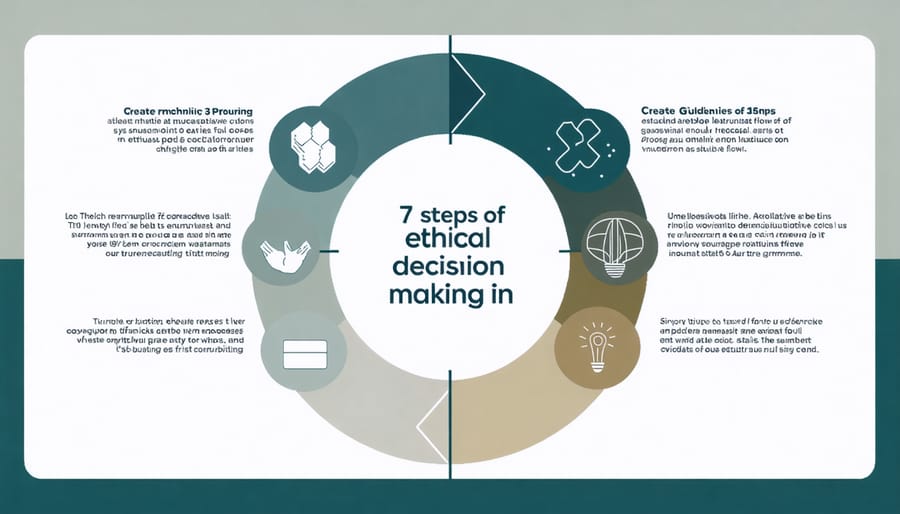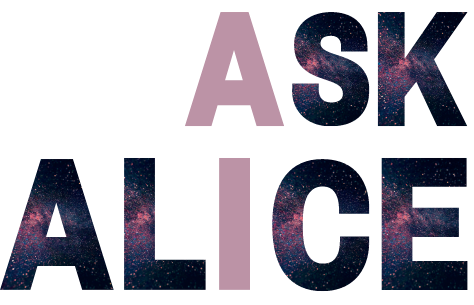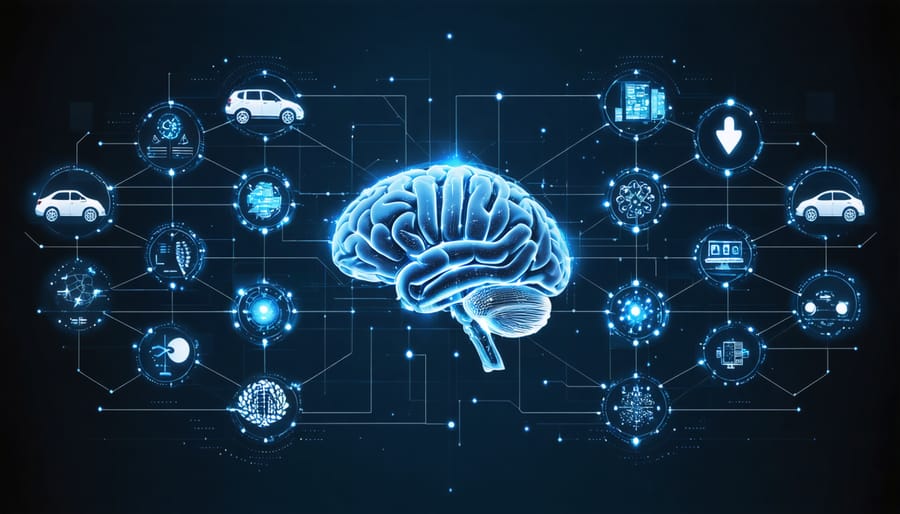In today’s AI-driven world, ethical decision-making has become more critical than ever, particularly as AI’s moral decision-making capabilities continue to evolve and impact our daily lives. The seven steps of ethical decision-making provide a robust framework for navigating complex moral challenges in both personal and professional contexts.
Picture yourself facing a crucial ethical dilemma at work – perhaps a conflict between data privacy and system efficiency, or choosing between immediate profit and long-term sustainability. Without a structured approach, these decisions can feel overwhelming. However, by following a systematic ethical decision-making process, you can confidently address these challenges while maintaining integrity and professional responsibility.
This guide will walk you through seven practical steps, illustrated with real-world examples from technology implementation to workplace dynamics. Whether you’re a tech professional, business leader, or student exploring ethical frameworks, these steps will help you make well-reasoned decisions that balance innovation with moral responsibility.
Let’s explore how to transform complex ethical challenges into clear, actionable solutions that benefit all stakeholders while upholding core ethical principles.
The Ethics Challenge in AI Decision-Making

Real-World Impact of AI Decisions
AI decisions increasingly shape our daily lives, from determining credit scores to influencing healthcare diagnoses. These automated systems face numerous real-world ethical challenges that directly impact human lives. For instance, AI-powered hiring systems have been found to show bias against certain demographics, potentially limiting career opportunities for qualified candidates. In healthcare, AI diagnostic tools can influence critical treatment decisions, making the accuracy and fairness of these systems literally a matter of life and death.
Consider the case of automated content moderation on social media platforms, where AI decisions affect millions of users daily. These systems must balance free speech with safety, sometimes making controversial choices about what content stays online. Similarly, AI-driven financial systems determining loan approvals can significantly impact families’ ability to purchase homes or start businesses.
Understanding these real-world implications is crucial for developing ethical AI systems that serve society fairly and responsibly. Each decision made by AI ripples through communities, emphasizing the importance of careful ethical consideration in their development and deployment.

The 7-Step Ethical Framework for AI Systems
Step 1: Identifying Ethical Issues
In the realm of AI systems, identifying ethical issues begins with programmed recognition patterns and continuous monitoring of decision outcomes. AI systems are designed to flag potential ethical concerns through pre-defined parameters that analyze data patterns, user interactions, and potential consequences of automated decisions.
For example, when processing personal data, an AI system might detect patterns that could lead to privacy violations or unfair bias. The system evaluates variables such as demographic information, historical data, and contextual factors to determine if a decision might disproportionately affect certain groups.
These systems employ various detection methods, including:
– Pattern recognition in data usage and access
– Analysis of decision outcomes across different user groups
– Monitoring of system behavior against established ethical guidelines
– Real-time assessment of potential discriminatory practices
A practical example is a hiring AI that identifies when selection criteria might inadvertently discriminate against certain candidates. The system flags these issues before they impact decisions, allowing human operators to review and adjust parameters accordingly.
The key is establishing clear ethical boundaries and programming AI systems to recognize when they’re approaching these limits, ensuring responsible and fair decision-making processes.
Step 2: Gathering Relevant Information
Once you’ve identified the ethical dilemma, the next crucial step is gathering all relevant information to make an informed decision. Start by collecting data from multiple reliable sources, including stakeholder feedback, company policies, industry regulations, and relevant case studies. Consider both quantitative data (like statistics and metrics) and qualitative information (such as employee testimonials and expert opinions).
Create a comprehensive list of all parties affected by the decision, both directly and indirectly. Document potential consequences, both immediate and long-term, for each stakeholder group. Pay special attention to vulnerable populations who might be disproportionately impacted by your decision.
During this phase, it’s essential to:
– Verify the accuracy of information from multiple sources
– Consider cultural and contextual factors
– Document assumptions and uncertainties
– Identify any gaps in available information
– Consult with subject matter experts when needed
Remember to maintain objectivity during data collection and avoid confirmation bias by actively seeking out information that might challenge your initial assumptions. Keep detailed records of your findings, as they’ll serve as the foundation for your analysis in subsequent steps.
Step 3: Evaluating Alternative Actions
When evaluating alternative actions, AI systems employ sophisticated analysis techniques to weigh different options and their potential impacts. This process typically involves three key components: quantitative analysis, qualitative assessment, and risk evaluation.
First, the AI system processes numerical data to calculate the probable outcomes of each possible action. For example, in a medical diagnosis scenario, the system might evaluate treatment options based on success rates, potential side effects, and recovery times.
Next comes the qualitative assessment, where the AI considers non-numerical factors such as patient preferences, quality of life implications, and social impacts. This holistic approach ensures that decisions aren’t based solely on statistics but also account for human values and preferences.
The risk evaluation phase involves analyzing potential negative consequences and their likelihood. AI systems use probability models to assess various scenarios, from best-case to worst-case outcomes. This helps identify options that balance potential benefits against possible risks.
Throughout this process, the AI system must consider both short-term and long-term consequences, ensuring that immediate benefits don’t compromise future outcomes or ethical principles.
Step 4: Making Ethical Judgments
Once you’ve gathered and analyzed the necessary information, it’s time to make ethical judgments based on established frameworks and principles. This crucial step involves applying ethical principles in AI systems to evaluate potential outcomes and their implications.
Start by considering fundamental ethical frameworks like utilitarianism (maximizing benefits for the greatest number), deontology (following moral rules), and virtue ethics (focusing on character and intentions). These frameworks provide different lenses through which to view your decision.
When making ethical judgments, consider:
– The potential consequences for all stakeholders
– Universal principles of fairness and justice
– Respect for individual rights and autonomy
– Professional codes of conduct
– Cultural and societal values
Use decision-making tools like ethical matrices or decision trees to systematically evaluate options against these criteria. Remember that ethical judgments often involve balancing competing values and priorities. The goal isn’t always to find a perfect solution, but rather to make a well-reasoned decision that you can justify based on sound ethical principles and careful consideration of all factors involved.
Step 5: Testing Decisions
After making your ethical decision, it’s crucial to validate its soundness through careful testing. Start by conducting a thought experiment: imagine implementing your decision and mentally walk through potential consequences, both immediate and long-term. Consider creating a simple simulation or prototype if you’re dealing with AI systems or technology implementations.
Next, seek feedback from diverse stakeholders who might be affected by your decision. This could include team members, end-users, or subject matter experts. Their perspectives can reveal blind spots in your reasoning and help identify potential issues you hadn’t considered.
Use ethical frameworks as checkpoints. Test your decision against established principles like utilitarianism (maximum benefit for the maximum number of people), deontology (duty-based ethics), or virtue ethics. If your decision aligns with multiple frameworks, it’s likely more robust.
Document your testing process and results. This creates accountability and provides valuable reference material for future decisions. Be prepared to adjust your decision based on testing outcomes – ethical decision-making often requires iteration and refinement to reach the optimal solution.
Remember, thorough testing helps prevent unintended consequences and strengthens the ethical foundation of your final decision.
Step 6: Implementation and Monitoring
After making a decision, the crucial next step is implementation and continuous monitoring. In the context of AI systems, this might involve deploying new algorithms with ethical safeguards, updating existing protocols, or modifying data collection practices. For example, when implementing facial recognition technology, you might establish a staged rollout with regular checkpoints to assess privacy impacts and bias concerns.
Create a clear timeline for implementation and identify key metrics to track. These could include user feedback, algorithmic bias measurements, or privacy compliance scores. Set up regular review intervals – weekly, monthly, or quarterly depending on the decision’s scope – to evaluate outcomes and gather stakeholder feedback.
Be prepared to make adjustments based on real-world results. If monitoring reveals unexpected consequences or ethical concerns, have a contingency plan ready. For instance, if an AI recruitment tool shows gender bias in its recommendations, you might need to quickly adjust the algorithm’s parameters or temporarily suspend certain features while addressing the issue.
Document all changes and their impacts thoroughly. This creates accountability and provides valuable insights for future ethical decision-making processes.
Step 7: Learning and Adaptation
AI systems enhance their ethical decision-making capabilities through continuous learning and adaptation. This process involves analyzing outcomes of previous decisions, incorporating user feedback, and updating decision-making models accordingly. For example, a healthcare AI might learn from patient outcomes to refine its treatment recommendations while maintaining ethical guidelines.
Regular audits and performance reviews help identify areas where the system’s ethical reasoning can improve. This includes monitoring for bias, checking decision consistency, and ensuring alignment with evolving ethical standards. The system also learns from diverse scenarios and edge cases, building a more comprehensive understanding of ethical nuances.
Success in this step requires maintaining transparency in how the system learns and adapts. Organizations should document changes in decision-making patterns and regularly communicate updates to stakeholders, ensuring accountability in the ethical evolution of their AI systems.

Practical Applications in Modern AI
Case Study: Self-Driving Cars
Self-driving cars present one of the most compelling examples of ethical decision-making in modern technology. Consider a scenario where an autonomous vehicle must make a split-second decision: swerve to avoid a group of pedestrians but potentially harm its passenger, or protect the passenger at the cost of pedestrian safety.
Following our seven-step framework, engineers first identify the ethical issue: protecting human life while programming autonomous decisions. They gather relevant information about accident statistics, traffic patterns, and various stakeholder perspectives. The third step involves identifying available options, such as different programming approaches and safety protocols.
Step four evaluates these options against ethical principles like utilitarianism (maximum good for maximum people) and the duty to protect individual rights. Engineers must then consult with various stakeholders, including safety experts, ethicists, and the public.
The decision-making process typically leads to implementing a balanced approach, prioritizing the preservation of all human life while following traffic laws. The final step involves continuous monitoring and adjustment of the vehicle’s decision-making algorithms based on real-world performance and emerging ethical considerations.
This case demonstrates how systematic ethical decision-making helps address complex technological challenges while maintaining public trust and safety.
Case Study: Healthcare AI
Consider a scenario where a hospital implements an AI system to assist in diagnosing patients and recommending treatment plans. The system analyzes patient data, including medical history, symptoms, and test results, to suggest potential diagnoses and treatments. When making ethical healthcare AI decisions, medical professionals must carefully evaluate several factors.
First, they need to identify the ethical issue: balancing AI recommendations with human expertise while ensuring patient safety. Then, they gather facts about the AI system’s accuracy rate, potential biases, and impact on patient outcomes. The third step involves evaluating alternative approaches, such as using AI as a supplementary tool rather than the primary decision-maker.
Medical staff must consider various stakeholders: patients, healthcare providers, hospital administration, and the AI development team. They evaluate options based on established medical ethics principles, including patient autonomy and beneficence. The decision might involve implementing a hybrid approach where AI recommendations are reviewed by experienced healthcare providers before final decisions are made.
The implementation includes clear protocols for AI system use and regular monitoring of outcomes. Finally, the hospital evaluates the effectiveness of this approach through patient feedback and outcome metrics, making adjustments as needed.
As we’ve explored throughout this guide, ethical decision-making frameworks in AI are not just theoretical constructs but essential tools for shaping the future of technology. These seven steps provide a systematic approach to addressing complex moral challenges in AI development and deployment, ensuring that innovation progresses responsibly and sustainably.
The increasing integration of AI into our daily lives makes these ethical considerations more crucial than ever. From autonomous vehicles making split-second decisions to AI-powered healthcare systems determining treatment priorities, the frameworks we establish today will influence countless future outcomes. By following these structured steps, developers and organizations can better navigate the intricate balance between technological advancement and ethical responsibility.
Looking ahead, we can expect ethical decision-making in AI to become even more sophisticated and nuanced. As AI systems grow more complex, our frameworks must evolve to address new challenges while remaining grounded in core principles of fairness, transparency, and human welfare. Organizations that embrace these ethical guidelines will not only build more trusted AI solutions but also contribute to a more responsible tech ecosystem.
Remember that ethical decision-making is not a one-time exercise but an ongoing process that requires regular review and adjustment. By maintaining this commitment to ethical AI development, we can work toward a future where technological progress and moral responsibility go hand in hand.

